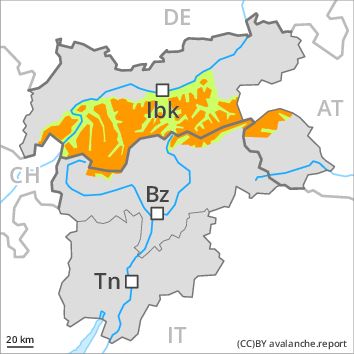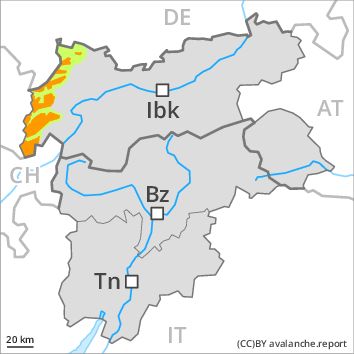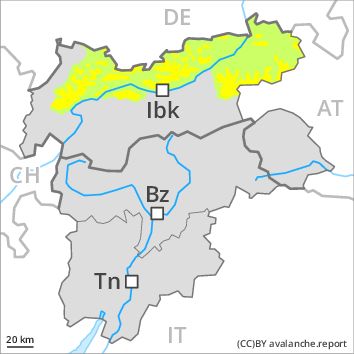Regions
Western Tuxer Alps, Eastern Tuxer Alps, Glockturm Range, Weißkugel Range, Gurgler Range, Schnals Ridge, Central Stubai Alps, Northern Zillertal Alps, Southern Zillertal Alps and High Tauern, Venediger Range, Samnaun Mountains, Northern Oetz and Stubai Alps

Danger level
Danger Level 3 - Considerable above the treeline
Danger Level 1 - Low above the treeline
Avalanche Problem
Wind-drifted snow above the treeline, N-NE-E-NW

Fresh wind slabs are to be evaluated critically.
As a consequence of fresh snow and strong wind there will be an increase in the avalanche danger to level 3 (considerable). Fresh and somewhat older wind slabs represent the main danger, caution is to be exercised in particular on steep northwest, north and east facing slopes as well as adjacent to ridgelines and in gullies and bowls. The number and size of avalanche prone locations will increase with altitude. Avalanches can mostly be released, even by a single winter sport participant and reach medium size.
A latent danger of gliding avalanches exists. Caution is to be exercised in areas with glide cracks.
Snowpack
dp 6: cold, loose snow and wind
dp 5: snowfall after a long period of cold
Over a wide area 10 to 20 cm of snow. will fall. The strong wind will transport the fresh and old snow. In some cases wind slabs are lying on soft layers.
Tendency
The avalanche danger will persist.
Regions
Western Lechtal Alps, Western Verwall Mountains, Eastern Verwall Mountains, Allgäu Alps, Silvretta

Danger level
Danger Level 3 - Considerable above the treeline
Danger Level 1 - Low above the treeline
Avalanche Problem
Wind-drifted snow above the treeline, N-NE-E-NW
New snow above the treeline, N-NE-E-NW

Fresh wind slabs are to be evaluated critically.
As a consequence of fresh snow and strong wind there will be an increase in the avalanche danger to level 3 (considerable). Fresh and somewhat older wind slabs represent the main danger, caution is to be exercised in particular on steep northwest, north and east facing slopes as well as adjacent to ridgelines and in gullies and bowls. The number and size of avalanche prone locations will increase with altitude. Avalanches can mostly be released, even by a single winter sport participant and reach medium size. Individual mostly small natural avalanches are possible.
A latent danger of gliding avalanches exists. Caution is to be exercised in areas with glide cracks.
Snowpack
dp 5: snowfall after a long period of cold
dp 6: cold, loose snow and wind
In some regions up to 40 cm of snow. will fall. The strong wind will transport the fresh and old snow. In some cases wind slabs are lying on soft layers.
Tendency
The avalanche danger will persist.
Regions
Sexten Dolomites, Latemar, Val Müstair Alps, Langtaufers, Southern Stubai Alps, Saldurn-Mastaun Ridge, Texel Mountains, Southern Adamello, Sarntal Alps, Adamello - Presanella, Western Pfunderer Mountains, Northern Brenta - Peller, Southern Brenta, Southern Lagorai, Northern Lagorai, Maddalene, Eastern Pfunderer Mountains, Durreck Range, Western Rieserferner Mountains, Western Deferegger Alps, Ortler Range, Ulten Valley, Eastern Nonsberger Alps, Northern Dolomites of Fiemme, Eastern Rieserferner Mountains, Gröden Dolomites, Primiero - Pale di S. Martino, Glockner Range, Prags Dolomites, Eastern Deferegger Alps, Schober Mountains, Lienzer Dolomites, Fassa Valley, Sole, Pejo and Rabbi, Paganella

Danger level
Danger Level 2 - Moderate above the treeline
Danger Level 1 - Low above the treeline
Avalanche Problem
Wind-drifted snow above the treeline, N-NE-E-SE-S-SW-W-NW

Fresh wind slabs require caution.
As a consequence of the strong northerly wind there will be an increase in the avalanche danger to level 2 (moderate). Fresh and somewhat older wind slabs represent the main danger, caution is to be exercised in particular on steep slopes in all aspects, especially adjacent to ridgelines and in gullies and bowls. The number and size of avalanche prone locations will increase with altitude. Avalanches can be released, even by a single winter sport participant and reach medium size. In regions neighbouring those that are subject to danger level 3 (considerable) avalanche prone locations are more prevalent and the danger is greater.
A latent danger of gliding avalanches exists. Caution is to be exercised in areas with glide cracks.
Snowpack
dp 6: cold, loose snow and wind
0 to 5 cm of snow. will fall, in particular in the north. The strong wind will transport the fresh and old snow. In some cases wind slabs are lying on soft layers.
Tendency
The avalanche danger will persist.
Regions
Karwendel Mountains, Brandenberg Alps, Western Kitzbühel Alps, Wilder Kaiser Mountains - Waidring Alps, Eastern Kitzbühel Alps, Central Lechtal Alps, Grieskogel Mountains, Eastern Lechtal Alps - Ammergau Alps, Mieming Mountains

Danger level
Danger Level 2 - Moderate above the treeline
Danger Level 1 - Low above the treeline
Avalanche Problem
Wind-drifted snow above the treeline, N-NE-NW

Fresh wind slabs require caution.
Only a little snow is lying in all altitude zones. As a consequence of fresh snow and wind the wind slabs will increase in size. This applies in particular on steep shady slopes adjacent to ridgelines and in gullies and bowls. Mostly avalanches are only small but easily released.
Snowpack
dp 6: cold, loose snow and wind
In some regions up to 30 cm of snow. will fall. As a consequence of a sometimes strong westerly wind, easily released wind slabs will form in particular adjacent to ridgelines and in gullies and bowls. In some cases wind slabs are lying on soft layers. This applies in particular on steep shady slopes.
No distinct weak layers exist in the old snowpack in all altitude zones. At low and intermediate altitudes hardly any snow is lying.
Tendency
The avalanche danger will persist.




